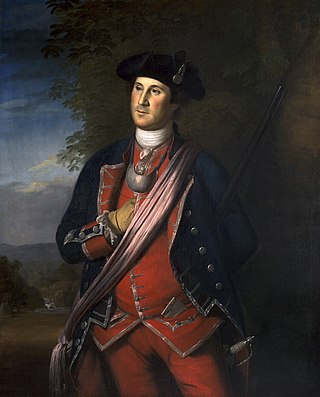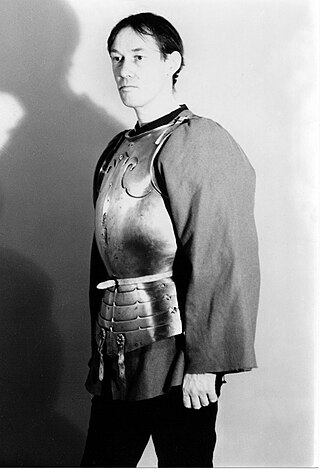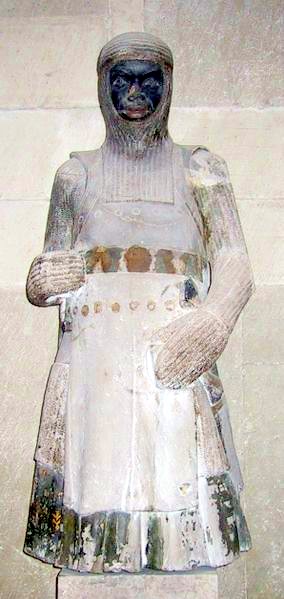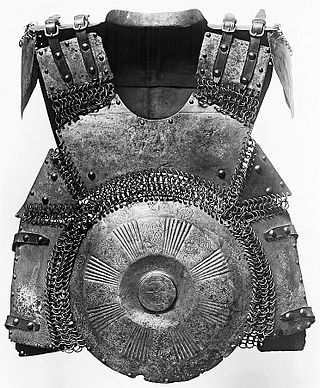
Armour or armor is a covering used to protect an object, individual, or vehicle from physical injury or damage, especially direct contact weapons or projectiles during combat, or from a potentially dangerous environment or activity. Personal armour is used to protect soldiers and war animals. Vehicle armour is used on warships, armoured fighting vehicles, and some mostly ground attack combat aircraft.

A cuirass is a piece of armour that covers the torso, formed of one or more pieces of metal or other rigid material. The word probably originates from the original material, leather, from the French cuirace and Latin word coriacea. The use of the term "cuirass" generally refers to both the chest plate and the back piece together; whereas a breastplate only protects the front, a cuirass protects both the front and the back.

Plate armour is a historical type of personal body armour made from bronze, iron, or steel plates, culminating in the iconic suit of armour entirely encasing the wearer. Full plate steel armour developed in Europe during the Late Middle Ages, especially in the context of the Hundred Years' War, from the coat of plates worn over mail suits during the 14th century.

Cuirassiers were cavalry equipped with a cuirass, sword, and pistols. Cuirassiers first appeared in mid-to-late 16th century Europe as a result of armoured cavalry, such as men-at-arms and demi-lancers, discarding their lances and adopting the use of pistols as their primary weapon. In the later part of the 17th century the cuirassier lost his limb armour and subsequently wore only the cuirass, and sometimes a helmet. By this time, the sword or sabre had become his primary weapon, with pistols relegated to a secondary function.

The bascinet – also bassinet, basinet, or bazineto – was a Medieval European open-faced combat helmet. It evolved from a type of iron or steel skullcap, but had a more pointed apex to the skull, and it extended downwards at the rear and sides to afford protection for the neck. A mail curtain was usually attached to the lower edge of the helmet to protect the throat, neck and shoulders. A visor was often employed from c. 1330 to protect the exposed face. Early in the fifteenth century, the camail began to be replaced by a plate metal gorget, giving rise to the so-called "great bascinet".

White armour, or alwyte armour, was a form of plate armour worn in the Late Middle Ages characterized by full-body steel plate without a surcoat. Around 1420 the surcoat, or "coat of arms" as it was known in England, began to disappear, in favour of uncovered plate. Areas not covered by plate were protected by mail sewn to the gambeson underneath.

A gorget, from the French gorge meaning throat, was a band of linen wrapped around a woman's neck and head in the medieval period or the lower part of a simple chaperon hood. The term later described a steel or leather collar to protect the throat, a set of pieces of plate armour, or a single piece of plate armour hanging from the neck and covering the throat and chest. Later, particularly from the 18th century, the gorget became primarily ornamental, serving as a symbolic accessory on military uniforms, a use which has survived in some armies.

The armet is a type of combat helmet which was developed in the 15th century. It was extensively used in Italy, France, England, the Low Countries and Spain. It was distinguished by being the first helmet of its era to completely enclose the head while being compact and light enough to move with the wearer. Its use was essentially restricted to the fully armoured man-at-arms.

A brigandine is a form of body armour from the Middle Ages. It is a garment typically made of heavy cloth, canvas, or leather, lined internally with small oblong steel plates riveted to the fabric, sometimes with a second layer of fabric on the inside.

A breastplate or chestplate is a device worn over the torso to protect it from injury, as an item of religious significance, or as an item of status. A breastplate is sometimes worn by mythological beings as a distinctive item of clothing. It is also a term for a piece of clothing used by drag queens and cross-dressing performers, which mimics a woman's cleavage or breasts.

Scale armour is an early form of armour consisting of many individual small armour scales (plates) of various shapes attached to each other and to a backing of cloth or leather in overlapping rows. Scale armour was worn by warriors of many different cultures as well as their horses. The material used to make the scales varied and included bronze, iron, steel, rawhide, leather, cuir bouilli, seeds, horn, or pangolin scales. The variations are primarily the result of material availability.

Faulds are pieces of plate armour worn below a breastplate to protect the waist and hips, which began to appear in Western Europe from about 1370. They consist of overlapping horizontal lames of metal, articulated for flexibility, that form an apron-like skirt in front. When worn with a cuirass, faulds are often paired with a similar defense for the rump called a culet, so that the faulds and culet form a skirt that surrounds the hips in front and back; the culet is often made of fewer lames than the fauld, especially on armor for a horseman. The faulds can either be riveted to the lower edge of the breastplate or made as a separate piece that the breastplate snugly overlaps. Although faulds varied in length, most faulds for field use ended above the knees.

The lobster-tailed pot helmet, also known as the zischägge, horseman's pot and harquebusier's pot, was a type of post-Renaissance combat helmet. It became popular in Europe, especially for cavalry and officers, from c. 1600; it was derived from an Ottoman Turkish helmet type. The helmet gradually fell out of use in most of Europe in the late 17th century; however, the Austrian heavy cavalry retained it for some campaigns as late as the 1780s.

A coat of plates is a form of segmented torso armour consisting of overlapping metal plates riveted inside a cloth or leather garment. The coat of plates is considered part of the era of transitional armour and was normally worn as part of a full knightly harness. The coat saw its introduction in Europe among the warring elite in the 1180s or 1220s and was well established by the 1250s. It was in very common usage by the 1290s. By the 1350s it was universal among infantry militias as well. After about 1340, the plates covering the chest were combined to form an early breastplate, replacing the coat of plates. After 1370, the breastplate covered the entire torso. Different forms of the coat of plates, known as the brigandine and jack of plates, remained in use until the late 16th century.

Mirror armour, sometimes referred to as disc armour or as chahār-āyneh or char-aina, was a type of cuirass used mainly in Asia, the Middle East, and Eastern Europe; including India, Persia, Tibet, Russia, and the Ottoman Empire. It literally translates to "four mirrors" which is a reflection of how these pieces looked, which resembles four metal discs or rectangular armour plates. Mirror armor was used in some cultures up to the 20th century.

Scholars agree that Japanese armour first appeared in the 4th century, with the discovery of the cuirass and basic helmets in graves. During the Heian period (794-1185), the unique Japanese samurai armour ō-yoroi and dō-maru appeared. The Japanese cuirass evolved into the more familiar style of body armour worn by the samurai known as the dou or dō, with the use of leather straps (nerigawa), and lacquer for weatherproofing. Leather and/or iron scales were also used to construct samurai armours, with leather and eventually silk lace used to connect the individual scales (kozane) of these cuirasses. In the 16th century, Japan began trading with Europe, during what would become known as the Nanban trade. This was the first time matchlock muskets were imported, and as they became mass-produced domestically, samurai needed lighter and more protective armour. As a result, a new style of armour called tosei-gusoku (gusoku), which means modern armour, appeared. When a united Japan entered the peaceful Edo period, samurai continued to use both plate and lamellar armour as a symbol of their status.

Greenwich armour is the plate armour in a distinctively English style produced by the Royal Almain Armoury founded by Henry VIII in 1511 in Greenwich near London, which continued until the English Civil War. The armoury was formed by imported master armourers hired by Henry VIII, initially including some from Italy and Flanders, as well as the Germans who dominated during most of the 16th century. The most notable head armourer of the Greenwich workshop was Jacob Halder, who was master workman of the armoury from 1576 to 1607. This was the peak period of the armoury's production and it coincided with the elaborately gilded and sometimes coloured decorated styles of late Tudor England.

Laminar armour is an armour made from horizontal overlapping rows or bands of, usually small, solid armour plates called lames, as opposed to lamellar armour, which is made from individual armour scales laced together to form a solid-looking strip of armour. Prominent examples of such armour are lorica segmentata of Ancient Rome and certain versions of samurai armour.

Dō or dou (胴) "breastplate, cuirass" is one of the major components of Japanese armour worn by the samurai and ashigaru or foot soldiers of feudal Japan.

Armour in the 18th century was minimalist and restricted almost entirely to cavalry, primarily to cuirassiers and, to a lesser degree, carabiniers and dragoons. Armour had been in rapid decline since the Thirty Years War, although some archaisms had lingered on into the early years of the 18th century, like Austrian cuirassiers with buff coats and lobster-tailed helmets or Hungarian warriors with mail armour and shields. With the exception of Poland-Lithuania, which still made use of hussars wearing suits of plate armour, armour in Europe was primarily restricted to a front- and backplate, the cuirass, and a simple iron skull cap worn under the hat. By the later 18th century, there were two contradicting developments. Many cuirassier regiments were discarding their cuirasses, while helmets in the form of so-called dragoon helmets, made of brass or leather, made a comeback among the cavalry and infantry.





















